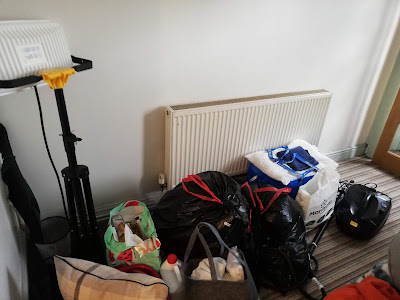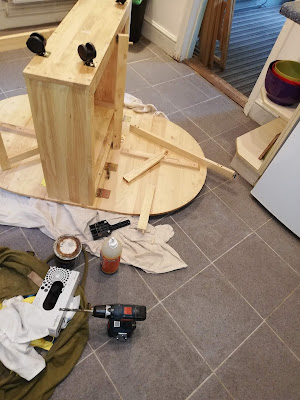In the previous post I told some of the story of fitting an environment sensor in the Cottage to remotely monitor the temperature to help compliance with insurance requirements during Winter periods of non-occupancy.
An unexpected side effect was that I discovered that the humidity levels in the cottage are a bit too high with a reading of 67% relative humidity. The is probably because we keep the windows closed while the place is not occupied during lockdown, but there is a certain amount of damp in the Victorian solid brick walls at the front of the house.
So to address this issue, I've rented an electric dehumidifier machine. Within the space of the first 12 hours, this relatively small box has brought the humidity down to 55% in the cottage. It extracted a 600 ml of water from the air. At present I've set the machine a target parameter to switch off when humidity around the machine is below 50%. It is located in one corner of the cottage, so it will take some time to evenly spread the humidity across the building. If the project shows good results I'll purchase a dehumidifier.
The machine is rated at 500 Watts, though when it is running it initially has an average power running cost of about 2p per hour (£16 month). However, the energy used in dehumidifying will offset the heating demand on the gas central heating. At the moment it is removing about 1 litre of water per day from the air, walls and contents of this one bedroom cottage. It will be interesting to see whether those figures reduce as the cottage "dries out".
The recommendation is that humidity in the room should be between 40% - 60%; if you read the adverts/articles from air conditioning suppliers, they suggest 40%, but I rather suspect a vested interest there. If you make the atmosphere too dry it can cause discomfort for guests.
Update 22nd Nov.
Yesterday, I reset the target humidity on the machine to 45% Relative Humidity, rather than 50%. At this setting it created 2 litres of condensate water, in 24 hours, while slightly increasing power usage. As the capacity of the condensate tank is just 5.5 litres, I'd need to visit the cottage once every two to three days to empty the tank. So I've just ordered a condensate syphon tank. I'll make arrangements to have a continuous condensate drain via the syphon into the kitchen sink. The syphon tank releases the condensate in batch amounts, rather than a steady trickle. This is much better on very cold winter days as it reduces the risk of the external drain pipe of the kitchen sink from freezing.
The dehumidifier we're using is rated at a maximum 20 litres extraction per day, but that is with an ambient room temperature of 30C. The extraction rate is reduced at lower temperatures.
The air volume inside the building can carry about 1.5 litres of water. Hopefully this will reduce in a few days, but in theory it could amount to 40 litres in a month.
Despite the higher extraction rate the Relative Humidity around the monitoring sensor remains around 54% (at 15.7C) which suggests there is some way to go before we reach stability.
























